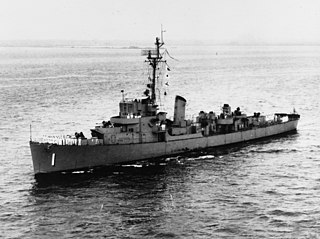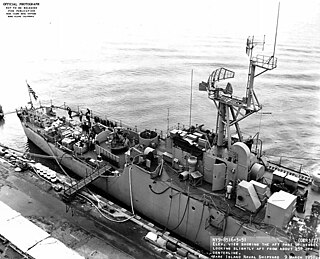
USS Hissem (DE-400/DER-400) was an Edsall class destroyer escort of the United States Navy. Hissem was constructed in 1943 as DE-400. In 1955, the vessel was equipped with modern radars, and the designation was changed to DER-400. The special purpose of DER ships was the detection of aircraft. Their chief role was to extend the DEW line out into the N. Atlantic and the N. Pacific oceans.

USS Atherton (DE-169), a Cannon-class destroyer escort, was the only ship of the United States Navy to be named for Lt. (jg) John McDougal Atherton, who died when USS Meredith sank near Guadalcanal during World War II.

USS Cabana (DE-260) was an Evarts-class destroyer escort constructed for the United States Navy during World War II. The namesake of this ship, Napoleon Joseph Cabana, was born in Fairhaven, Massachusetts on 26 March 1911, Cabana enlisted in the Navy on 17 March 1930 and was appointed machinist on 2 February 1941. As assistant safety engineer of the Cavite Navy Yard, Philippines, he was killed in action during Japanese attacks on that base on 12 December 1941.

USS Hemminger (DE-746) was a Cannon-class destroyer escort in service with the United States Navy from 1944 to 1946 and from 1950 to 1958. In 1959, she was transferred to Thailand, where she serves as HTMS Pin Klao. She is the only Cannon-class destroyer escort still in service.

USS Fessenden (DE-142/DER-142) was an Edsall-class destroyer escort built for the U.S. Navy during World War II. She served in the Atlantic Ocean and the Pacific Ocean and provided destroyer escort protection against submarine and air attack for Navy vessels and convoys.

USS Blair (DE-147) was an Edsall-class destroyer escort in service with the United States Navy from 1943 to 1946 and from 1951 to 1960. She was scrapped in 1974. Blair was named in honor of Chief Machinist's Mate Eugene Blair, who was awarded the Silver Star posthumously for his brave actions when his ship was attacked and bombed by Japanese planes near Port Darwin, Australia, in mid-February 1942.

USS Otterstetter (DE-244) was an Edsall-class destroyer escort built for the U.S. Navy during World War II. She served in the Atlantic Ocean the Pacific Ocean and provided destroyer escort protection against submarine and air attack for Navy vessels and convoys.

USS Harveson (DE-316) was an Edsall-class destroyer escort built for the U.S. Navy during World War II. She served in the Atlantic Ocean the Pacific Ocean and provided destroyer escort protection against submarine and air attack for Navy vessels and convoys.

USS Joyce (DE-317) was originally commissioned as a US Coast Guard Edsall-class destroyer escort built for the U.S. Navy during World War II. She served in the Atlantic Ocean and the Pacific Ocean and provided destroyer escort protection against submarine and air attack for Navy vessels and convoys. During its World War II service, on two different engagements with enemy submarines, the Joyce rescued survivors of the tanker SS Pan- Pennsylvania and its sister ship USS Leopold. Joyce received one battle star for its service during World War II.

USS Kirkpatrick (DE-318) was an Edsall-class destroyer escort built for the U.S. Navy during World War II. She served in the Atlantic Ocean the Pacific Ocean and provided destroyer escort protection against submarine and air attack for Navy vessels and convoys. Post-war, she was converted to a radar picket ship to support the DEW Line.

USS Falgout (DE-/DER-324) was an Edsall-class destroyer escort built for the U.S. Navy during World War II. She served in the Atlantic Ocean and provided destroyer escort protection against submarine and air attack for Navy vessels and convoys. Post-war, she was borrowed by the U.S. Coast Guard and also served as a radar picket ship on the Distant Early Warning Line. She was reclassified DER-324 on 28 October 1954.

USS Koiner (DE-331) was an Edsall-class destroyer escort built for the U.S. Navy during World War II. She served in the Atlantic Ocean and the Pacific Ocean and provided destroyer escort protection against submarine and air attack for Navy vessels and convoys. Post-war, she was loaned to the U.S. Coast Guard, and also reclassified as a radar picket ship.

USS Roy O. Hale (DE-336) was an Edsall-class destroyer escort in service with the United States Navy from 1944 to 1946 and from 1957 to 1963. She was scrapped in 1975.

USS Martin H. Ray (DE-338) was an Edsall-class destroyer escort built for the U.S. Navy during World War II. She served in the Atlantic Ocean and the Pacific Ocean and provided destroyer escort protection against submarine and air attack for Navy vessels and convoys.

USS Ramsden (DE-382) was an Edsall-class destroyer escort built for the U.S. Navy during World War II. She served in the Atlantic Ocean and the Pacific Ocean and provided destroyer escort protection against submarine and air attack for Navy vessels and convoys. Post-war, she performed other tasks with the U.S. Coast Guard and with the U.S. Navy as a radar picket ship.

USS Mills (DE-383) was an Edsall-class destroyer escort built for the U.S. Navy during World War II. She served in the Atlantic Ocean and the Pacific Ocean and provided destroyer escort protection against submarine and air attack for Navy vessels and convoys. Post-war, she performed additional duties for the Navy, including those of a radar picket ship and a safety and support ship for Operation Deep Freeze.

USS Calcaterra (DE-390) was an Edsall-class destroyer escort built for the U.S. Navy during World War II. She served in the Atlantic Ocean and the Pacific Ocean and provided destroyer escort protection against submarine and air attack for Navy vessels and convoys. Post-war she was called up again for duty, this time as a radar picket ship.

USS Haverfield (DE-393) was an Edsall-class destroyer escort built for the U.S. Navy during World War II. She served in the Atlantic Ocean and the Pacific Ocean and provided destroyer escort protection against submarine and air attack for Navy vessels and convoys.

USS Woodson (DE-359) was a John C. Butler-class destroyer escort acquired by the United States Navy during World War II. The primary purpose of the destroyer escort was to escort and protect ships in convoy, in addition to other tasks as assigned, such as patrol or radar picket.
USS Johnnie Hutchins (DE-360) was a John C. Butler-class destroyer escort acquired by the U.S. Navy during World War II. The primary purpose of the destroyer escort was to escort and protect ships in convoy, in addition to other tasks as assigned, such as patrol or radar picket. She served in the Pacific Ocean, and, post-war, she returned home with a Navy Unit Commendation awarded to her for her battle with Japanese midget submarines on 9 August 1945.



















